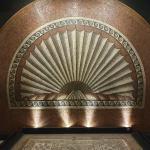Verulamium Museum, St Albans
Verulamium began life in pre-Roman Britain as the tribal centre of the CatuvellauniA British Iron Age tribe in south-eastern Britain, with lands north of the Thames., but flourished after the Claudian invasion of 43 CE'Common era', the non-religious way of saying AD ('anno Domini', or 'the year of our lord').. It thus attracted the attention - and wrath - of Boudica and her army in the revolt of 60/61, when the town was burned to the ground. Despite this, it was rebuilt and grew to become one of the largest Roman towns in Britain, even boasting the first saint - St Alban - to be martyred in Britain. The Verulamium Museum is, therefore, perfectly placed to tell the story of life before and during the Roman occupation.

The museum itself is reasonably small, probably covering no more than 800m², but don't let the size put you off: it is TARDIS-esque in its use of space, and a surprising number of artefactsObjects made by humans that are of historical interest. and displays have been well-placed in its rooms. These displays cover everything from the Iron AgeThe Iron Age of the British Isles covers the period from about 800BCE to the Roman invasion of 43CE, and follows on from the Bronze Age. history of the site and the fascinating discovery of the high-status burial at Folly Lane, through the Roman war machine, to everyday life of Romano-British people. They include some fantastic artefacts - tiles with paw prints, the somewhat-ghoulish but still compelling excavated remains of adult and infant skeletons, and the Sandridge Hoard of 159 gold coins (one of the largest such finds in the country) - interspersed with recreated Roman rooms, beautiful mosaics and some surprisingly well-preserved frescoes. A few videos show on a loop to explain certain parts of the history of Verulamium, as well as particular archeological finds and concepts. There are also a number of things for little people to do, such as constructing archways, magnifying Roman coins, mosaic-making, dress-up, and the ubiquitous activity sheet.

A visit lasting an hour or two can be extended by taking a wander around the neighbouring Verulamium Park, which contains an ornamental lake and children's play area, as well as fragments of the Roman walls and the London Gate. Within the site is a covered mosaic, but be warned that it keeps separate opening times from the main museum. Not included within the ticket price of the main museum, but available at an additional charge of £4 for a family ticket, is entrance to the remains of the Roman theatre, just a short walk away. 2020 entrance prices for just the museum are £6 per adult and £15 for a family ticket; £7.50 for an adult combined ticket, and £19 for a combined family ticket. There is, therefore, probably enough to keep the family entertained for an afternoon, for a reasonable price (be warned that parking costs extra, with no change given. Parking is also limited - we had to wait about half an hour on a cold January afternoon to park, so I imagine parking can be horrendous in the summer holidays).
2020 entrance prices for just the museum are £6 per adult and £15 for a family ticket; £7.50 for an adult combined ticket, and £19 for a combined family ticket. There is, therefore, probably enough to keep the family entertained for an afternoon, for a reasonable price (be warned that parking costs extra, with no change given. Parking is also limited - we had to wait about half an hour on a cold January afternoon to park, so I imagine parking can be horrendous in the summer holidays).

However, St Albans is pretty and worthy of a look in and of itself, and is great for history buffs: the cathedral not only has the longest nave in the country but is also the oldest site of continuous Christian worship in Britain; the Great Gateway next door - which can only be seen from the outside - featured in the Peasants' Revolt and is said to have housed one of the earliest printing presses in England; St Michael's Church is one of the best preserved Anglo-Saxon buildings in the country; and the remains of a Tudor mansion, Lee House, stand in the grounds of Sopwell Nunnery. Plus, the city has an excellent collection of eateries and pubs, some of which are housed in glorious buildings: my favourite is Ye Olde Fighting Cocks (fighting, it would seem, to be the oldest pub in the country), housed in a delightfully quirky Tudor-style building between the museum and the cathedral.
The Verulamium Museum by itself therefore makes a pleasant, engaging, informative, and inexpensive diversion for a Sunday afternoon. But when combined with everything else in its vicinity, it contributes towards a fabulous, history- and fun-filled day out for the whole family.
- Log in to post comments







